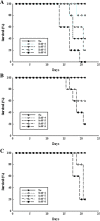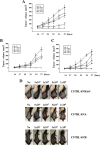Comparison of responsiveness to cancer development and anti-cancer drug in three different C57BL/6N stocks
- PMID: 32257905
- PMCID: PMC7081605
- DOI: 10.1186/s42826-019-0015-z
Comparison of responsiveness to cancer development and anti-cancer drug in three different C57BL/6N stocks
Abstract
In our efforts to understand the systemic features of tumors, the importance of animal models is increasing due to the recent growth in the development of immunotherapy and targeted therapies. This has resulted in increased attention towards tumor animal models using C57BL/6N, which are mainly used in immunological studies. In this study, the C57BL/6NKorl stock and two other commercial stocks (C57BL/6NA and C57BL/N6B) are evaluated by comparing the occurrence of tumors using the syngeneic model; furthermore, we compare the response to anti-cancer drugs in the syngeneic model by evaluating survival, growth of tumors, proliferation and molecular biology analysis. In the syngeneic model using LLC (Lewis lung carcinoma) cells, the survival of mice and growth of the tumor showed a better response in the C57BL/6NKorl stock, and was dependent on the cell concentration of the dosing tumor, as compared to the other C57BL/6N stocks. However, the Ki-67 staining showed only little difference in cell proliferation within the tumor tissue each mouse stocks. Comparing the sensitivity to anti-cancer drug by examining changes in growth, volume and weight revealed that cisplatin treatment for tumor-bearing C57BL/6NKorl was more dependent on concentration. The Ki-67 staining, however, showed no difference among the C57BL/6N stocks after cisplatin treatment. The expressions of p27 and p53 tumor suppressor proteins, caspase-3 and Bax showed dose-dependent increase after exposure to cisplatin, whereas the expression of Bcl-2 was reduced in a dose-dependent manner. Furthermore, the expressions of MMP-2 and VEGF involved in metastasis, as well as inflammatory genes IL-1β, IL-6 and IL-10, showed dose-dependent decrease in tumor tissue after cisplatin exposure. Differences observed among the C57BL/6N stocks were not significant. Taken together, our studies reveal that C57BL/6NKorl has the potential of being a useful biological resource established in Korea, as it does not differ from the two commercially available C57BL/6N stocks when considering response to tumor generation and sensitivity to anti-cancer drugs using the syngeneic tumor model.
Keywords: C57BL/6N; C57BL/6NKorl; Cisplatin; Syngeneic tumor model.
© The Author(s) 2019.
Conflict of interest statement
Competing interestsThe authors declare that they have no competing interests.
Figures





References
LinkOut - more resources
Full Text Sources
Research Materials
Miscellaneous

